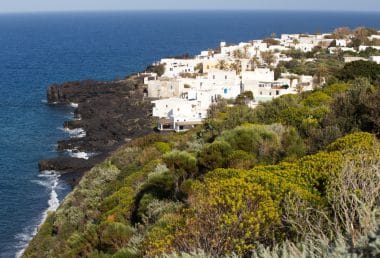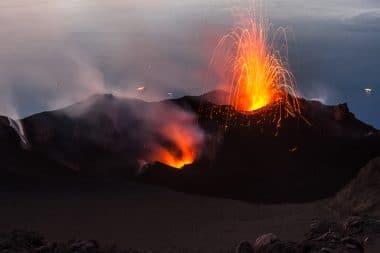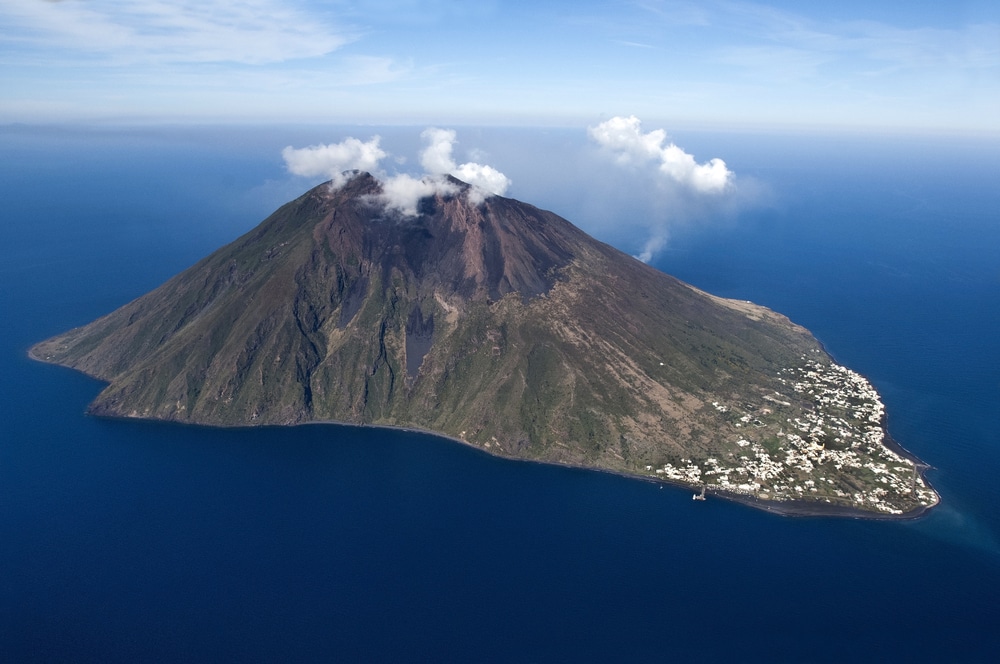The island of Stromboli is one of the Aeolian Islands and is located off the coast of Sicily. The island is characterized by the Stromboli volcano of the same name, whose volcanic activity allowed the island to tower above sea level in the first place.
Viewed from the sea, the island has the shape of a cone, as the volcano occupies almost the entire area of the island, which is 12.6 square kilometers. The highest point of the island is located at the top of the volcano and is 926 meters above sea level, which is very exceptional for such a small island.
The name of the island comes from Greek and is probably due to sailors from ancient Greece . Translated, the name of the island is said to mean “round island”, as the volcano formed the island in a round shape due to its nature as a stratovolcano.
Stromboli can now be reached by boat from Naples, Milazzo and Messina.
The inhabitants of the island

Even today, Stromboli is sparsely inhabited. The volcanic mountain makes it largely impossible to build villages on the island. Since there is no space for fields or pastures, not many people on the island were able to supply themselves with food in the past.
A total of 572 people live on Stromboli spread over two villages. In the northeast of the island is the largest settlement on the island, which is also called Stromboli. Over time, it has grown together from several smaller villages and today forms the center of the island.
In the southwest of the island there is still the village of Ginostra. However, only 30 people live here, isolated by land from the rest of the island’s inhabitants. To get from Ginostra to the village of Stromboli, you would have to climb the volcano. That’s why boats run regularly between the two villages.
There are almost no cars on the island. Only in the larger village of Stromboli there are some cars, but there are also some electric scooters and small trucks here.
Sights of the island
The reason why most people visit the island is because of the volcano. It is one of the few still active volcanoes in Europe and is therefore a popular destination for people who want to experience the power of nature.
The volcanic crater can be reached from the two villages of the island, but an ascent from the village of Stromboli is much more common than from Ginostra.

It is forbidden under penalty to climb the volcano alone. Tourists can group up and then climb the volcano under the guidance of a local guide. The ascent takes several hours and is very strenuous, especially in summer under the strong southern Italian sun. So if you are considering the climb, you should have sufficient fitness and safe footwear, as the paths are covered by scree.
The ascent usually starts in the afternoon so that the summit can be reached at nightfall. Because then visitors can better observe the small, regular eruptions of the volcano. Small lava fountains and clouds of smoke almost always rise in the crater of the volcano.
On the northwest side of the crater, a steep slope has formed, known among locals as the “fire slide”. During larger eruptions, the lava flows from the crater into the sea.
General information
- Layer: Stromboli is a small island in the Tyrrhenian Sea, belonging to the Aeolian Islands (or Aeolian Islands), located north of Sicily in Italy.
- Area: The island has an area of about 12.6 square kilometers.
- Population: Stromboli has around 500 permanent residents, although this number rises sharply in the summer months due to tourists.
Volcano:
- Active volcano: Stromboli is known for its active volcano, which is one of the most active in the world and erupts almost continuously. It is often referred to as the “lighthouse of the Mediterranean” because its eruptions are visible from afar.
- Activity: The volcano often displays small explosions that eject ash and lava chunks into the air. Larger eruptions occur less frequently, but there is always the possibility of a stronger eruption.
Nature and Environment:
- Landscape: The island has a steep, volcanic landscape with black beaches created by the volcano’s lava flows. The highest point of the volcano is about 926 meters above sea level.
- Cliffs and coves: In addition to the black beaches, there are also steep cliffs and rocky coves that characterize the coast of Stromboli.
Tourism:
- Volcano hikes: One of the most popular activities on Stromboli is the guided hike to the crater rim of the volcano, from where you can observe the volcanic activity at night. The hike requires a certain level of physical fitness and should only be undertaken with a licensed guide.
- Beaches: Stromboli also offers some secluded beaches such as the Spiaggia di Ficogrande, known for its volcanic black sand beaches.
- Boat: Boat tours around the island are also popular, where you can explore the coastline and the neighboring, uninhabited island of Strombolicchio, a small rock in the sea.
Reachability:
- Ferries: Stromboli is accessible by ferry from several cities in Italy, including Naples, Milazzo and Messina. In high season, there are more frequent connections, both by ferry and speedboat.
- Transportation on the island: There are no cars on Stromboli, only small electric scooters or bicycles. Most people move along the coast on foot or by boat.
Special features:
- Village of Stromboli: The island’s main village, also called Stromboli, is located on the slope of the volcano and offers charming white houses, narrow streets and a relaxed, idyllic atmosphere. There is also the smaller village of Ginostra, which is only accessible by boat.
- Strombolicchio: A small rocky island near Stromboli, on which an old lighthouse stands, is a popular destination for excursions by boat.
- Safety: Due to the continuous volcanic activity, there are strict safety guidelines. Volcanologists constantly monitor the eruptions, and there are evacuation plans in case of emergencies.
Culture and history:
- Mythology: In ancient Greek mythology, the Stromboli volcano was associated with the god of wind, Aiolos, who lived in the Aeolian Islands.
- Celebrity: Stromboli became internationally known through the 1950 film “Stromboli” with Ingrid Bergman, directed by Roberto Rossellini.


